Discrepancies on Storm Surge Predictions by Parametric Wind Model and Numerical Weather Prediction Model in a Semi-Enclosed Bay: Case Study of Typhoon Haiyan
Abstract
:1. Introduction
2. Methodology
2.1. Storm Surge Model
2.2. Parametric Holland Wind Model
2.3. WRF-ARW Model
2.4. Storm Track and Parameters of Haiyan
2.5. Computational Setup of Storm Surge Modeling
3. Results and Discussions
3.1. Validation of Parametric Holland Wind Model
3.2. Haiyan’s Storm Surge Simulation by HWM
3.3. Haiyan’s Storm Surge Simulation by WRF-ARW
3.4. Experiment for Storm Forward Speed
4. Conclusions
Author Contributions
Funding
Acknowledgments
Conflicts of Interest
References
- Fritz, H.M.; Blount, C.; Sokoloski, R.; Singleton, J.; Fuggle, A.; McAdoo, B.G.; Moore, A.; Grass, C.; Tate, B. Hurricane Katrina Storm Surge Distribution and Field Observations on the Mississippi Barrier Islands. Estuar. Coast. Shelf Sci. 2007, 74, 12–20. [Google Scholar] [CrossRef]
- Zhang, W.Z.; Shi, F.; Hong, H.S.; Shang, S.P.; Kirby, J.T. Tide-Surge Interaction Intensified by the Taiwan Strait. J. Geophys. Res. 2010, 115. [Google Scholar] [CrossRef] [Green Version]
- Tang, Y.M.; Sanderson, B.; Holland, G.J.; Grimshaw, R. A Numerical Study of Storm Surges and Tides, with Application to the North Queensland Coast. J. Phys. Oceanogr. 1996, 26, 2700–2711. [Google Scholar] [CrossRef] [Green Version]
- Mastenbroek, C.; Burgers, G.; Janssen, P. The Dynamical Coupling of a Wave Model and a Storm Surge Model through the Atmospheric Boundary Layer. J. Phys. Oceanogr. 1993, 23, 1856–1866. [Google Scholar] [CrossRef] [Green Version]
- Bunya, S.; Dietrich, J.C.; Westerink, J.J.; Ebersole, B.A.; Smith, J.M.; Atkinson, J.H.; Jensen, R.; Resio, D.T.; Luettich, R.A.; Dawson, C.; et al. A High-Resolution Coupled Riverine Flow, Tide, Wind, Wind Wave, and Storm Surge Model for Southern Louisiana and Mississippi. Part I: Model Development and Validation. Mon. Weather Rev. 2010, 138, 345–377. [Google Scholar] [CrossRef] [Green Version]
- Dietrich, J.C.; Bunya, S.; Westerink, J.J.; Ebersole, B.A.; Smith, J.M.; Atkinson, J.H.; Jensen, R. A High-Resolution Coupled Riverine Flow, Tide, Wind, Wind Wave, and Storm Surge Model for Southern Louisiana and Mississippi. Part II: Synoptic Description and Analysis of Hurricanes Katrina and Rita. Mon. Weather Rev. 2010, 138, 378–404. [Google Scholar] [CrossRef] [Green Version]
- Schiermeier, Q. Did Climate Change Cause Typhoon Haiyan? Nature 2013. [Google Scholar] [CrossRef]
- Elsner, J.B.; Kossin, J.P.; Jagger, T.H. The Increasing Intensity of the Strongest Tropical Cyclones. Nature 2008, 455, 92–95. [Google Scholar] [CrossRef]
- Zhong, L.; Li, M.; Zhang, D.L. How do uncertainties in hurricane model forecasts affect storm surge predictions in a semi-enclosed bay? Estuar. Coast. Shelf Sci. 2010, 90, 61–72. [Google Scholar] [CrossRef]
- Skamarock, W.C.; Klemp, J.B.; Dudhia, J.; Gill, D.O.; Barker, D.M.; Duda, M.G.; Huang, X.Y.; Wang, W.; Powers, J.G. A description of the advanced research WRF version 3. NCAR Tech. 2008, 113. [Google Scholar] [CrossRef]
- Tsuboki, K.; Sakakibara, A. Large-scale parallel computing of cloud resolving storm simulator. In International Symposium on High Performance Computing; Springer: Berlin/Heidelberg, Germany, 2002; pp. 243–259. [Google Scholar]
- Dee, D.P.; Uppala, S.M.; Simmons, A.J.; Berrisford, P.; Poli, P.; Kobayashi, S.; Andrae, U.; Balmaseda, M.A.; Balsamo, G.; Bauer, D.P.; et al. The ERA-Interim reanalysis: Configuration and performance of the data assimilation system. Q. J. R. Meteorol. Soc. 2011, 137, 553–597. [Google Scholar] [CrossRef]
- Mori, N.; Kato, M.; Kim, S.; Mase, H.; Shibutani, Y.; Takemi, T.; Tsuboki, K.; Yasuda, T. Local Amplification of Storm Surge by Super Typhoon Haiyan in Leyte Gulf. Geophys. Res. Lett. 2014, 41, 5106–5113. [Google Scholar] [CrossRef] [PubMed] [Green Version]
- Li, F.; Song, J.; Xia, L. A preliminary evaluation of the necessity of using a cumulus parameterization scheme in high-resolution simulations of Typhoon Haiyan (2013). Natl. Hazards 2018, 92, 647–671. [Google Scholar] [CrossRef]
- Kueh, M.T.; Chen, W.M.; Sheng, Y.F.; Lin, S.C.; Wu, T.R.; Yen, E.; Tsai, Y.L.; Lin, C.Y. Effects of horizontal resolution and air-sea flux parameterization on the intensity and structure of simulated Typhoon Haiyan (2013). Natl. Hazards Earth Syst. Sci. 2018, 19, 1509–1539. [Google Scholar] [CrossRef] [Green Version]
- Jelesnianski, C.; Chen, J.; Shaffer, W.; Gilad, A. A Hurricane Storm Surge Forecast Model. In Proceedings of the SLOSH, Washington, DC, USA, 10–12 September 1984. [Google Scholar] [CrossRef]
- Wu, T.R.; Tsai, Y.L.; Terng, C.T. The Recent Development of Storm Surge Modeling in Taiwan. Proc. IUTAM 2017, 25, 70–73. [Google Scholar] [CrossRef]
- Kim, S.; Mori, N.; Mase, H.; Yasuda, T. The Role of Sea Surface Drag in a Coupled Surge and Wave Model for Typhoon Haiyan 2013. Ocean Model. 2015, 96, 65–84. [Google Scholar] [CrossRef]
- Kumagai, K.; Mori, N.; Nakajo, S. Storm Surge Hindcast and Return Period of a Haiyan-Like Super Typhoon. Coast. Eng. J. 2016, 58, 1640001-1–1640001-24. [Google Scholar] [CrossRef]
- Li, N.; Roeber, V.; Yamazaki, Y.; Heitmann, T.W.; Bai, Y.; Cheung, K.F. Integration of Coastal Inundation Modeling from Storm Tides to Individual Waves. Ocean. Model. 2014, 83, 26–42. [Google Scholar] [CrossRef]
- Li, N.; Yamazaki, Y.; Roeber, V.; Cheung, K.F.; Chock, G. Probabilistic Mapping of Storm-Induced Coastal Inundation for Climate Change Adaptation. Coast. Eng. 2018, 133, 126–141. [Google Scholar] [CrossRef]
- Jeong, C.K.; Panchang, V.; Demirbilek, Z. Parametric adjustments to the rankine vortex wind model for Gulf of Mexico hurricanes. J. Offshore Mech. Arct. Eng. 2012, 134, 041102. [Google Scholar] [CrossRef]
- Jelesnianski, C.P. Slosh: Sea, Lake and Overland Surges from Hurricanes; US Department of Commerce, National Oceanic and Atmospheric Administration, National Weather Service: Silver Spring, MD, USA, 1992; Volume 48.
- Holland, G.J. An Analytic Model of the Wind and Pressure Profiles in Hurricanes. Mon. Weather Rev. 1980, 108, 1212–1218. [Google Scholar] [CrossRef]
- Xie, L.; Bao, S.; Pietrafesa, L.J.; Foley, K.; Fuentes, M. A Real-Time Hurricane Surface Wind Forecasting Model: Formulation and Verification. Mon. Weather Rev. 2006, 134, 1355–1370. [Google Scholar] [CrossRef]
- Holland, G.J.; Belanger, J.I.; Fritz, A. A Revised Model for Radial Profiles of Hurricane Winds. Mon. Weather Rev. 2010, 138, 4393–4401. [Google Scholar] [CrossRef]
- Lin, N.; Chavas, D. On hurricane parametric wind and applications in storm surge modeling. J. Geophys. Res. Atmos. 2012, 117, D9. [Google Scholar] [CrossRef]
- Liu, F.; Sasaki, J. Hybrid methods combining atmospheric reanalysis data and a parametric typhoon model to hindcast storm surges in Tokyo Bay. Sci. Rep. 2019, 9, 1–10. [Google Scholar] [CrossRef] [PubMed]
- Hsiao, S.C.; Chen, H.; Wu, H.L.; Chen, W.B.; Chang, C.H.; Guo, W.D.; Chen, Y.M.; Lin, L.Y. Numerical Simulation of Large Wave Heights from Super Typhoon Nepartak (2016) in the Eastern Waters of Taiwan. J. Mar. Sci. Eng. 2020, 8, 217. [Google Scholar] [CrossRef] [Green Version]
- Cheung, K.F.; Phadke, A.C.; Wei, Y.; Rojas, R.; Douyere, Y.M.; Martino, C.D.; Houstan, S.H.; Liao, S. Modeling of storm-induced coastal flooding for emergency management. Ocean. Eng. 2003, 30, 1353–1386. [Google Scholar] [CrossRef]
- NDRRMC. Effects of Typhoon “YOLANDA” (HAIYAN) Technical Report; National Disaster Risk Reduction and Management Council: Quezon City, Philippines, 2014.
- Takagi, H.; Esteban, M.; Shibayama, T.; Mikami, T.; Matsumaru, R.; de Leon, M.; Nakamura, R. Track analysis, simulation, and field survey of the 2013 Typhoon Haiyan storm surge. J. Flood Risk Manag. 2017, 10, 42–52. [Google Scholar] [CrossRef]
- Tajima, Y.; Yasuda, T.; Pacheco, B.M.; Cruz, E.C.; Kawasaki, K.; Nobuoka, H.; Aquino, R. Initial report of JSCE-PICE joint survey on the storm surge disaster caused by Typhoon Haiyan. Coast. Eng. J. 2014, 56, 1450006. [Google Scholar] [CrossRef]
- Mas, E.; Bricker, J.; Kure, S.; Adriano, B.; Yi, C.; Suppasri, A.; Koshimura, S. Field survey report and satellite image interpretation of the 2013 Super Typhoon Haiyan in the Philippines. Natl. Hazards Earth Syst. Sci. 2015, 15. [Google Scholar] [CrossRef] [Green Version]
- Soria, J.L.A.; Switzer, A.D.; Villanoy, C.L.; Fritz, H.M.; Hope, P.; Bilgera, T.; Cabrera, O.C.; Siringan, F.P.; Maria, Y.T.S.; Ramos, R.D.; et al. Repeat Storm Surge Disasters of Typhoon Haiyan and Its 1897 Predecessor in the Philippines. Bull. Am. Meteorol. Soc. 2016, 97, 31–48. [Google Scholar] [CrossRef]
- Mikami, T.; Shibayama, T.; Takagi, H.; Matsumaru, R.; Esteban, M.; Thao, N.D.; Kumagaim, K. Storm surge heights and damage caused by the 2013 Typhoon Haiyan along the Leyte Gulf coast. Coast. Eng. J. 2016, 58, 1640005. [Google Scholar] [CrossRef]
- Takayabu, I.; Hibino, K.; Sasaki, H.; Shiogama, H.; Mori, N.; Shibutani, Y.; Takemi, T. Climate change effects on the worst-case storm surge: A case study of Typhoon Haiyan. Environ. Res. Lett. 2015, 10, 064011. [Google Scholar] [CrossRef]
- Tajima, Y.; Gunasekara, K.H.; Shimozono, T.; Cruz, E.C. Study on locally varying inundation characteristics induced by super Typhoon Haiyan. Part 1: Dynamic behavior of storm surge and waves around San Pedro Bay. Coast. Eng. J. 2016, 58, 1640002. [Google Scholar] [CrossRef] [Green Version]
- Szydłowski, M.; Kolerski, T.; Zima, P. Impact of the Artificial Strait in the Vistula Spit on the Hydrodynamics of the Vistula Lagoon (Baltic Sea). Water 2019, 11, 990. [Google Scholar] [CrossRef] [Green Version]
- Dean, R.G.; Dalrymple, R.A. Water Wave Mechanics for Engineers and Scientists; World Scientific Publishing Company: Singapore, 1991; Volume 2. [Google Scholar]
- Liang, S.-J.; Young, C.C.; Dai, C.; Wu, N.J.; Hsu, T.W. Simulation of Ocean Circulation of Dongsha Water Using Non-Hydrostatic Shallow-Water Model. Water 2016, 12, 2832. [Google Scholar] [CrossRef]
- Lapidez, J.P.; Tablazon, J.; Dasallas, L.; Gonzalo, L.A.; Cabacaba, K.M.; Ramos, M.M.A.; Suarez, J.K.; Santiago, J.; Lagmay, A.M.F.; Malano, V. Identification of storm surge vulnerable areas in the Philippines through the simulation of Typhoon Haiyan-induced storm surge levels over historical storm tracks. Natl. Hazards Earth Syst. Sci. 2015, 3. [Google Scholar] [CrossRef] [Green Version]
- Lagmay, A.M.F.; Agaton, R.P.; Bahala, M.A.C.; Briones, J.B.L.T.; Cabacaba, K.M.C.; Caro, C.V.C.; Dasallas, L.L.; Gonalo, L.A.L.; Ladiero, C.N.; Lapidez, J.P.; et al. Devastating storm surges of Typhoon Haiyan. Int. J. Dis. Risk Reduct. 2015, 11, 1–12. [Google Scholar] [CrossRef]
- Liu, P.L.F.; Cho, Y.S.; Briggs, M.J.; Kanoglu, U.; Synolakis, C.E. Runup of solitary waves on a circular island. J. Fluid Mech. 1995, 302, 259–285. [Google Scholar] [CrossRef]
- Liu, P.L.F.; Cho, Y.S.; Yoon, S.B.; Seo, S.N. Numerical simulations of the 1960 Chilean tsunami propagation and inundation at Hilo, Hawaii. In Tsunami: Progress in Prediction, Disaster Prevention and Warning; Springer: Dordrecht, The Netherlands, 1995; pp. 99–115. [Google Scholar]
- Wang, X.; Liu, P.L.F. An analysis of 2004 Sumatra earthquake fault plane mechanisms and Indian Ocean tsunami. J. Hydraul. Res. 2006, 44, 147–154. [Google Scholar] [CrossRef]
- Li, L.; Qiu, Q.; Huang, Z. Numerical modeling of the morphological change in Lhok Nga, west Banda Aceh, during the 2004 Indian Ocean tsunami: Understanding tsunami deposits using a forward modeling method. Natl. Hazards 2012, 64, 1549–1574. [Google Scholar] [CrossRef]
- Lin, S.C.; Wu, T.R.; Yen, E.; Chen, H.Y.; Hsu, J.; Tsai, Y.L.; Philip, L.F. Development of a tsunami early warning system for the South China Sea. Ocean. Eng. 2015, 100, 1–18. [Google Scholar] [CrossRef]
- Takagi, H.; Li, S.; Leon, M.; Esteban, M.; Mikami, T.; Matsumaru, R.; Shibayama, T.; Nakamura, R. Storm surge and evacuation in urban areas during the peak of a storm. Coast. Eng. 2016, 108, 1–9. [Google Scholar] [CrossRef] [Green Version]
- Garzon, J.L.; Ferreira, C.M. Storm surge modeling in large estuaries: Sensitivity analyses to parameters and physical processes in the Chesapeake Bay. J. Marine Sci. Eng. 2016, 4, 45. [Google Scholar] [CrossRef] [Green Version]
- Graham, L.; Butler, T.; Walsh, S.; Dawson, C.; Westerink, J.J. A measure-theoretic algorithm for estimating bottom friction in a coastal inlet: Case study of bay st. Louis during hurricane Gustav (2008). Mon. Weather Rev. 2017, 145, 929–954. [Google Scholar] [CrossRef]
- Wu, J. Wind-stress coefficients over sea surface from breeze to hurricane. J. Geophys. Res. Oceans 1982, 87, 9704–9706. [Google Scholar] [CrossRef]
- Liu, P.L.F.; Woo, S.B.; Cho, Y.S. Computer Programs for Tsunami Propagation and Inundation; Technical Report; Cornell University: New York, NY, USA, 1998. [Google Scholar]
- Tsai, Y.L. The Development of Storm Surge Fast Calculation System and the Reconstruction of 1845 Yunlin Kouhu Event. Master’s Thesis, National Central University, Taoyuan, Taiwan, 2014. [Google Scholar]
- Arakawa, A.; Lamb, V.R. Computational design of the basic dynamical processes of the UCLA general circulation model. Gen. Circ. Models Atmos. 1977, 17, 173–265. [Google Scholar]
- Kim, S.Y.; Mori, N.; Shibutani, Y.; Yasuda, T.; Mase, H. Hindcast of storm surges and waves caused by Typhoon Haiyan using a coupling model of surge and wave. J. JSCE B2 Coast. Eng. 2014, 70, I_226–I_230. [Google Scholar]
- Phadke, A.C.; Martino, C.D.; Cheung, K.F.; Houston, S.H. Modeling of tropical cyclone winds and waves for emergency management. Ocean. Eng. 2003, 30, 553–578. [Google Scholar] [CrossRef]
- Schloemer, R.W. Analysis and Synthesis of Hurricane Wind Patterns over Lake Okeechobee; US Department of Commerce Weather Bureau: Miami, FL, USA, 1954.
- Tan, C.; Fang, W. Mapping the wind hazard of global tropical cyclones with parametric wind field models by considering the effects of local factors. Int. J. Dis. Risk Sci. 2018, 9, 86–99. [Google Scholar] [CrossRef] [Green Version]
- Harper, B.A.; Holland, G.J. An updated parametric model of the tropical cyclone. In Proceedings of the 23rd Conference Hurricanes and Tropical Meteorology, Dallas, TX, USA, 10–15 January 1999. [Google Scholar]
- Shea, D.J.; Gray, W.M. The hurricane’s inner core region. I. Symmetric and asymmetric structure. J. Atmos. Sci. 1973, 30, 1544–1564. [Google Scholar] [CrossRef] [Green Version]
- Ou, S.H.; Liau, J.M.; Hsu, T.W.; Tzang, S.Y. Simulating typhoon waves by SWAN wave model in coastal waters of Taiwan. Ocean. Eng. 2002, 29, 947–971. [Google Scholar] [CrossRef]
- JMA Best Track Database. 2020. Available online: https://www.jma.go.jp/jma/jma-eng/jma-center/rsmc-hp-pub-eg/besttrack.html (accessed on 20 June 2020).
- Weatherall, P.; Marks, K.M.; Jakobsson, M.; Schmitt, T.; Tani, S.; Arndt, J.E.; Rovere, M.; Chayes, D.; Ferrini, V.; Wigley, R. A new digital bathymetric model of the world’s oceans. Earth Space Sci. 2015, 2, 331–345. [Google Scholar] [CrossRef]
- Bode, L.; Hardy, T.A. Progress and Recent Developments in Storm Surge Modeling. J. Hydraul. Eng. 1997, 123, 315–331. [Google Scholar] [CrossRef]
- Bricker, J.D.; Takagi, H.; Mas, E.; Kure, S.; Adriano, B.; Yi, C.; Roeber, V. Spatial Variation of Damage due to Storm Surge and Waves during Typhoon Haiyan in the Philippines. J. Jpn. Soc. Civil. Eng. Ser. B2 Coast. Eng. 2014, 70, 231–235. [Google Scholar] [CrossRef] [Green Version]
- Hsu, S.A.; Meindl, E.A.; Gilhousen, D.B. Determining the power-law wind-profile exponent under near-neutral stability conditions at sea. Appl. Meteorol. 1994, 33, 757–765. [Google Scholar] [CrossRef] [Green Version]
- Paciente, R.B. Response and lessons learned from Typhoon “Haiyan” (Yolanda). In JMA/WMO Workshop on Effective Tropical Cyclone Warning in Southeast Asia; Japan Meteorology Agency Tokyo: Tokyo, Japan, 2014. [Google Scholar]
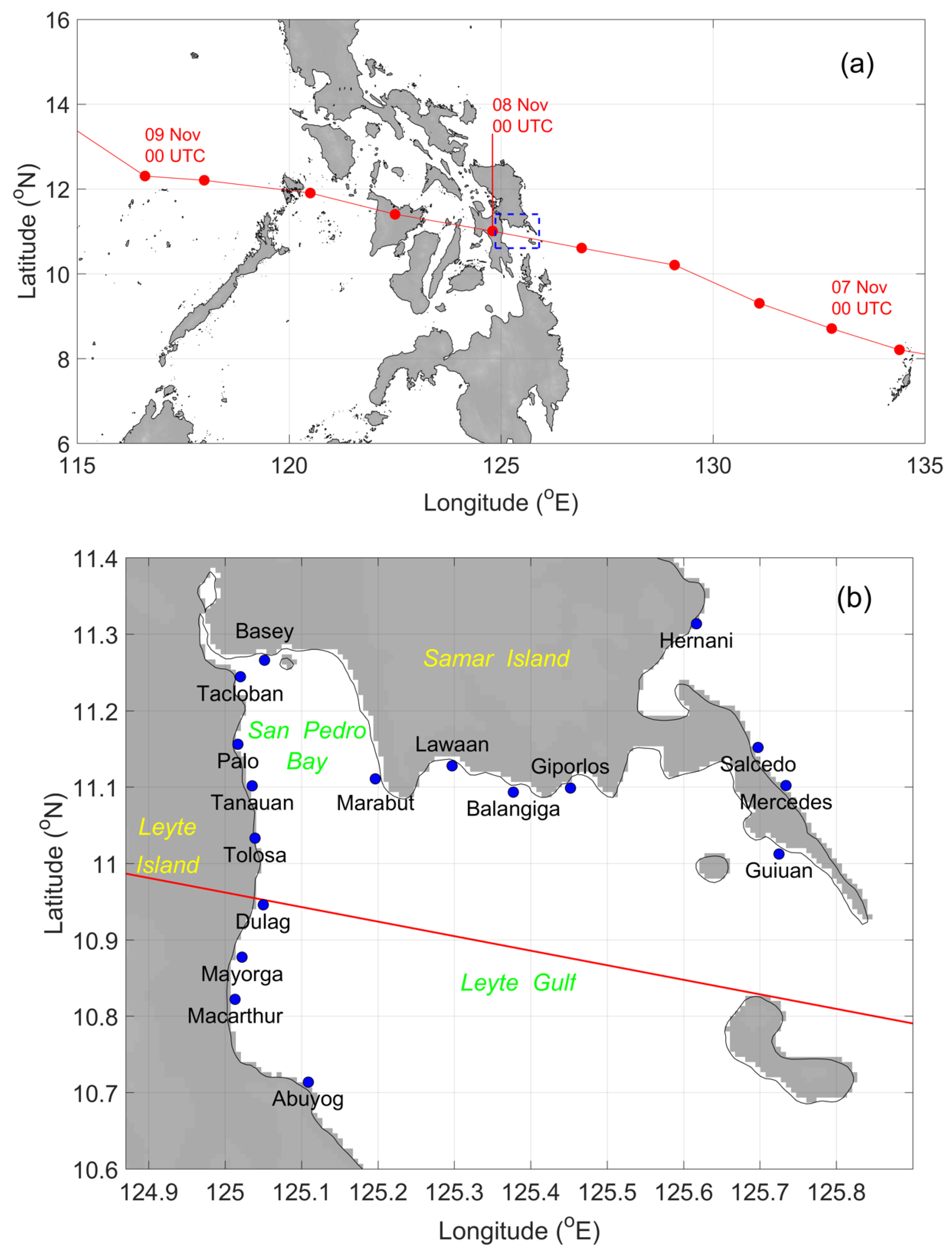
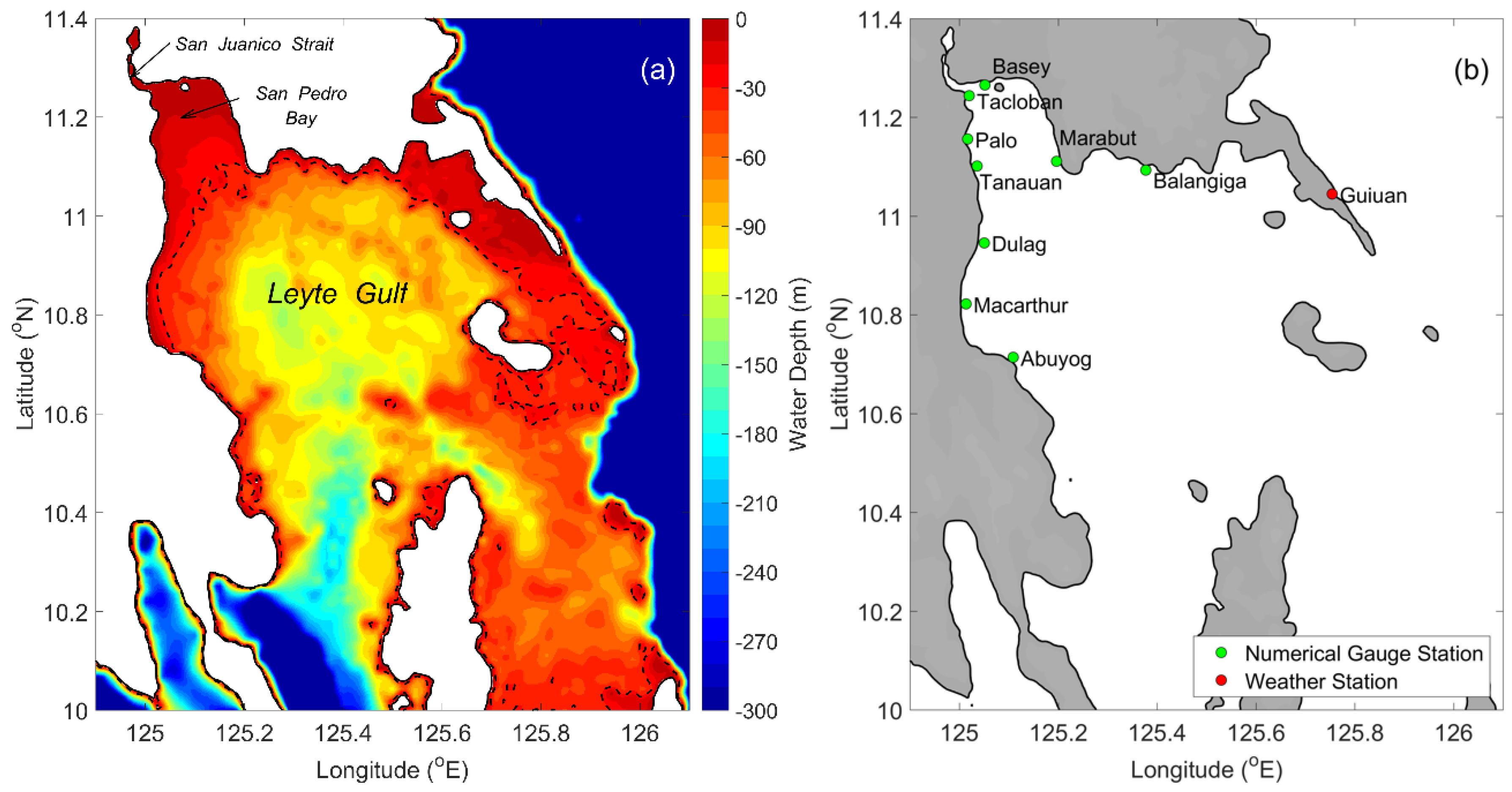

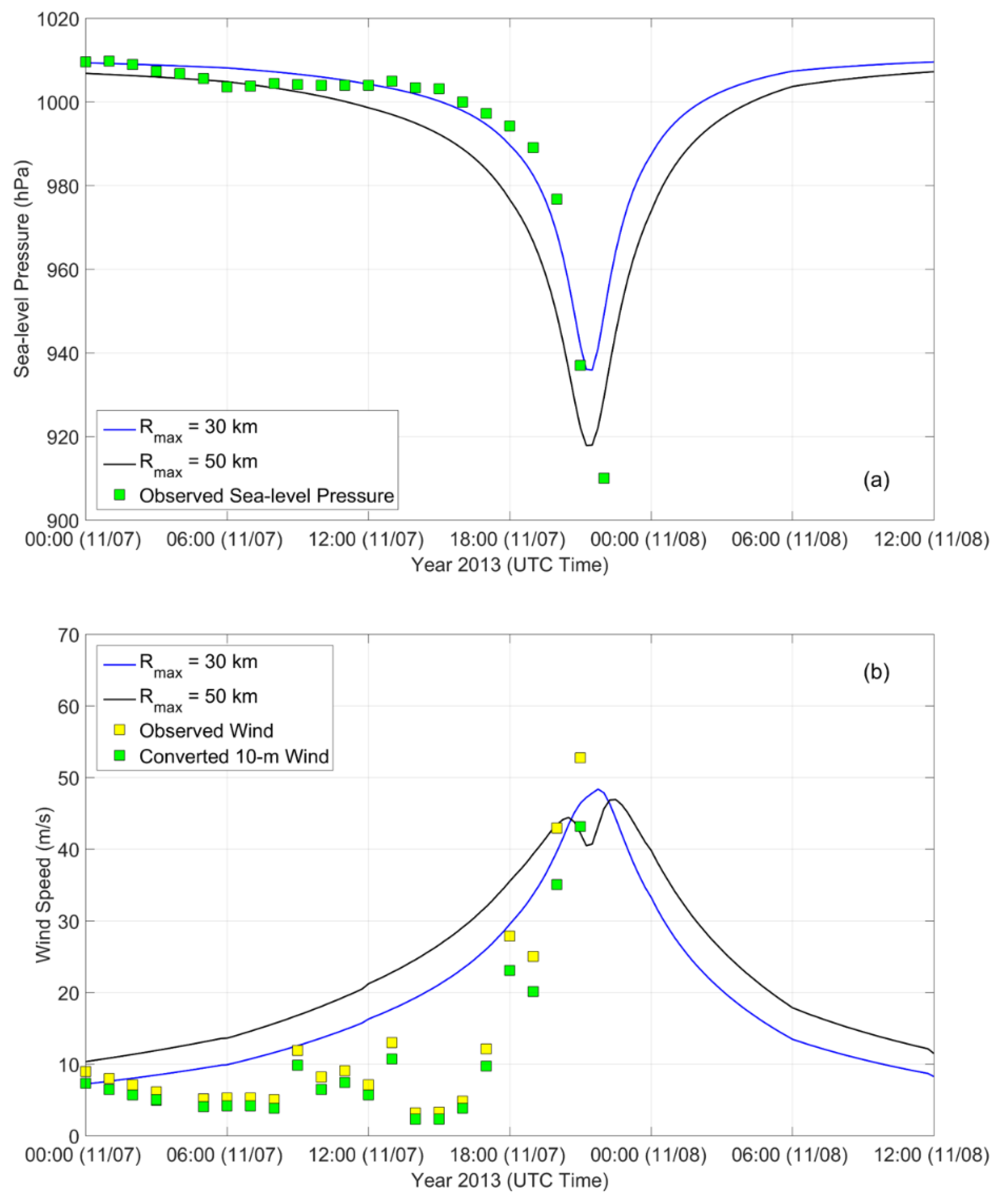

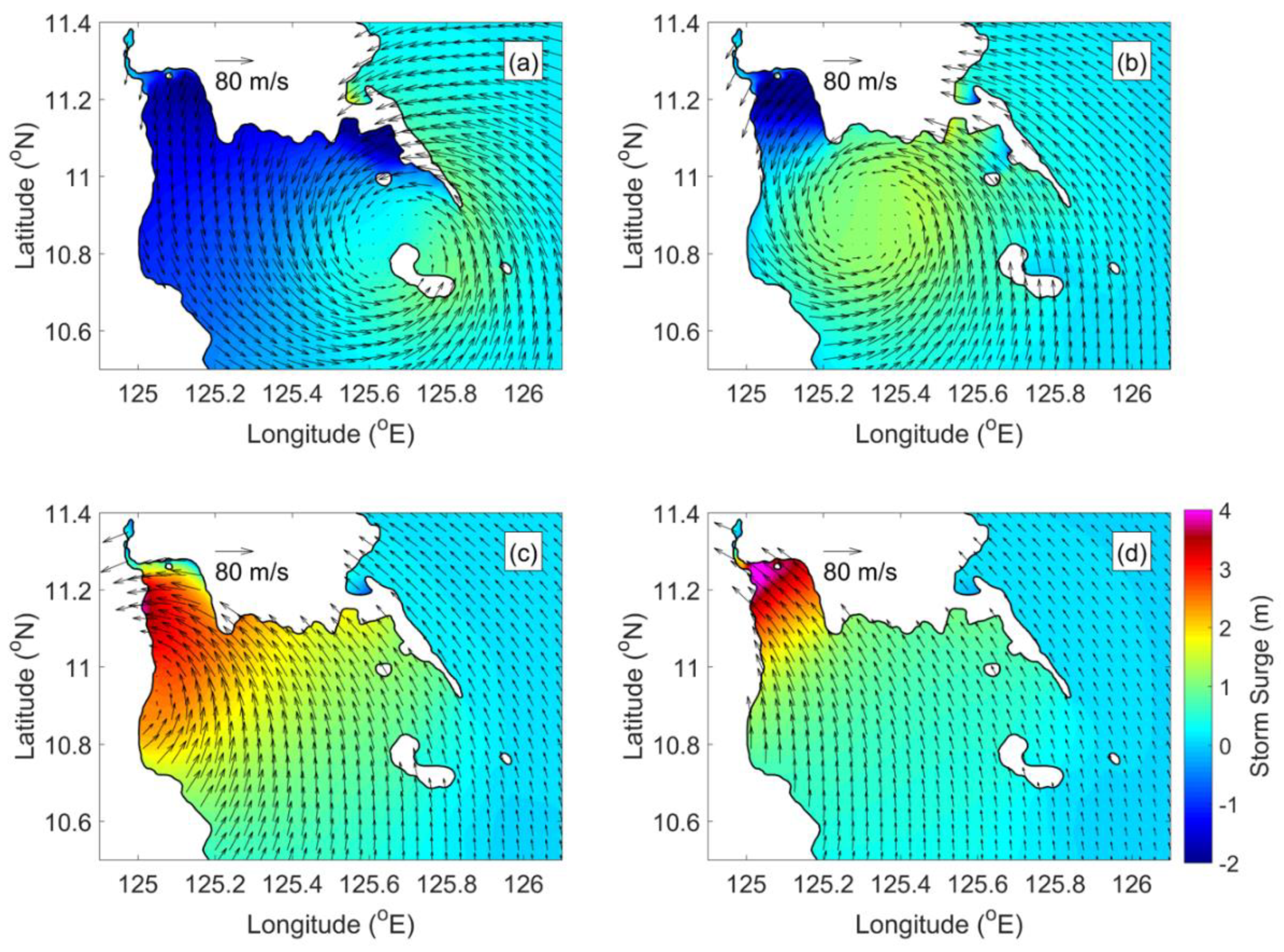
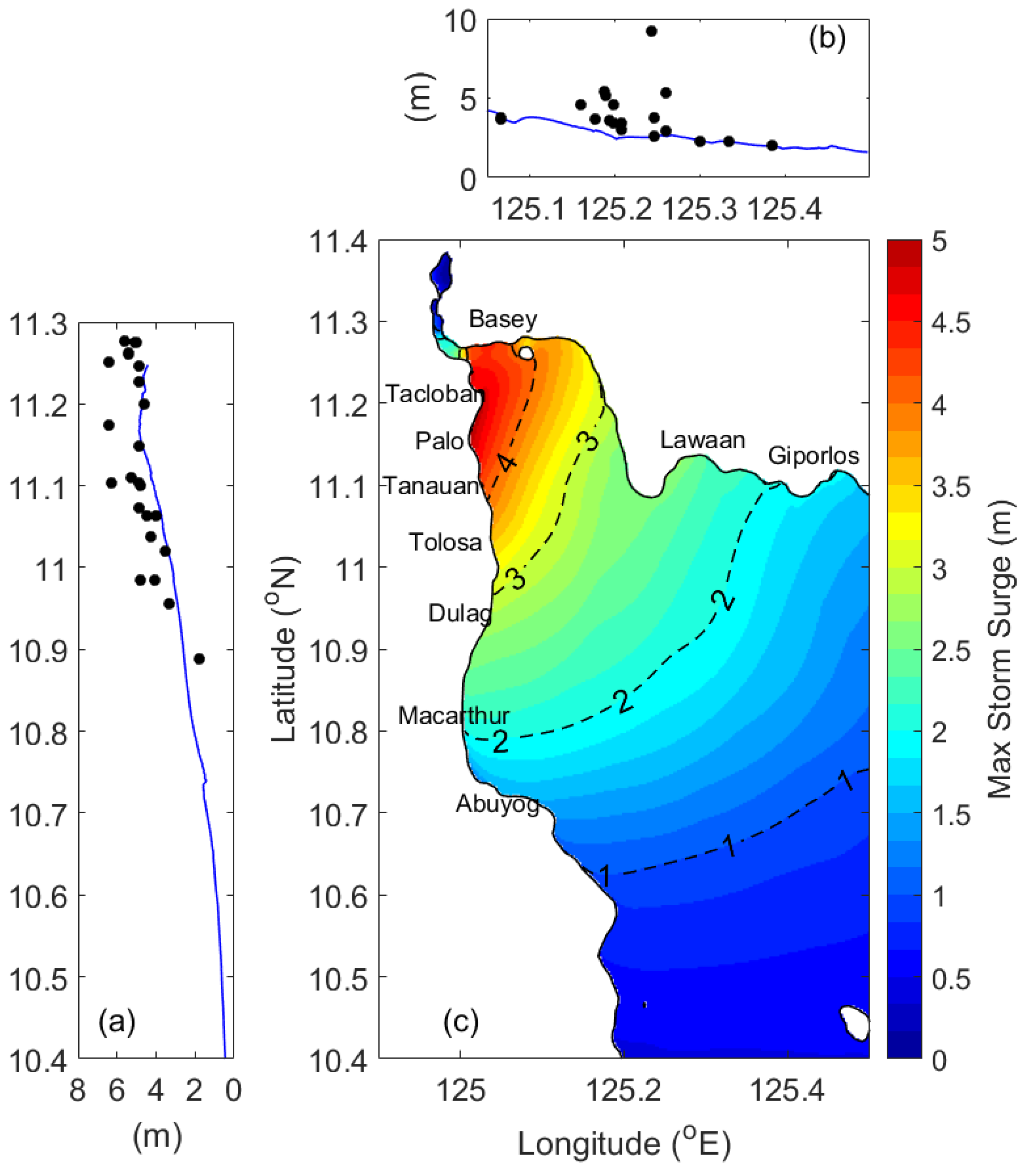
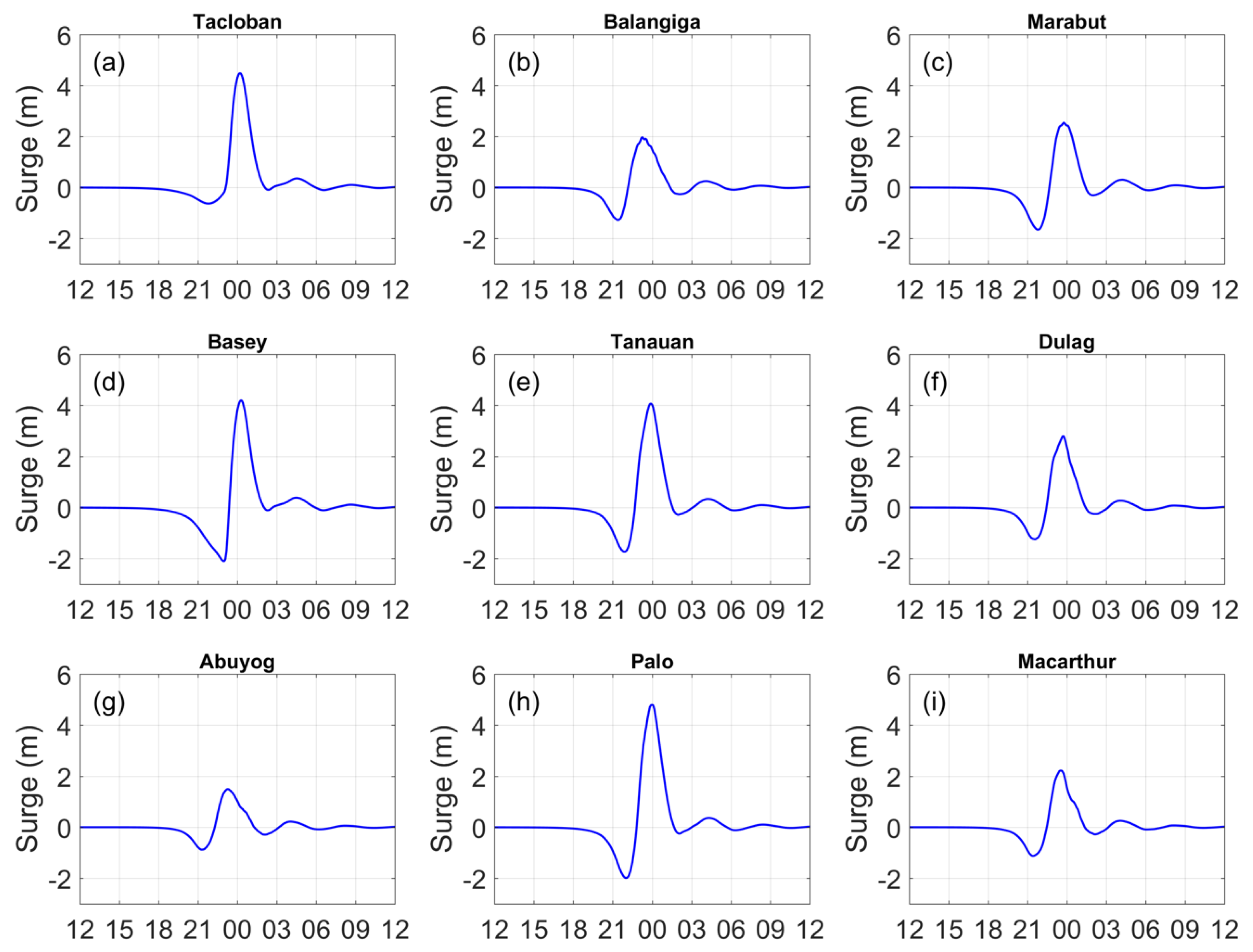

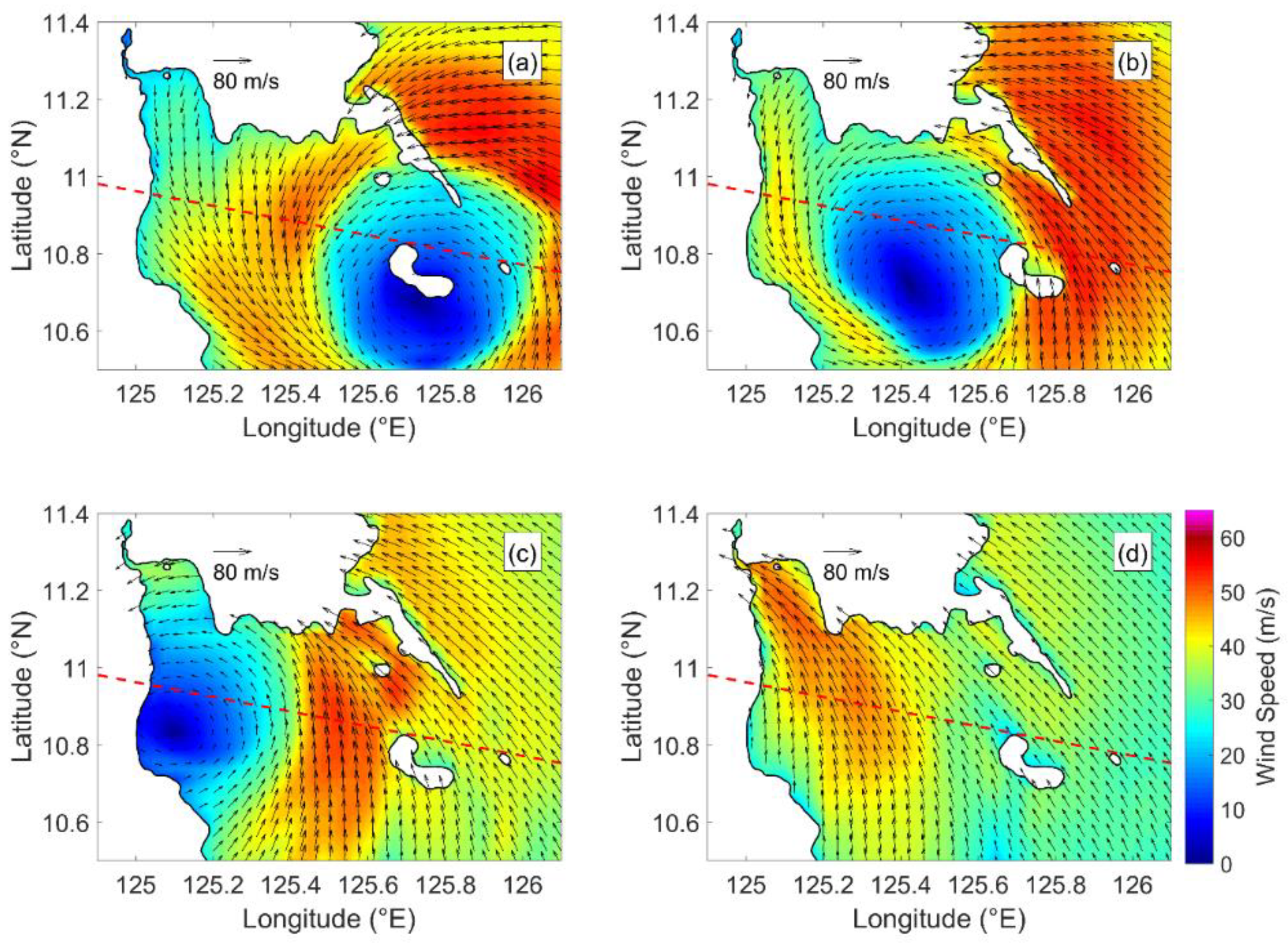

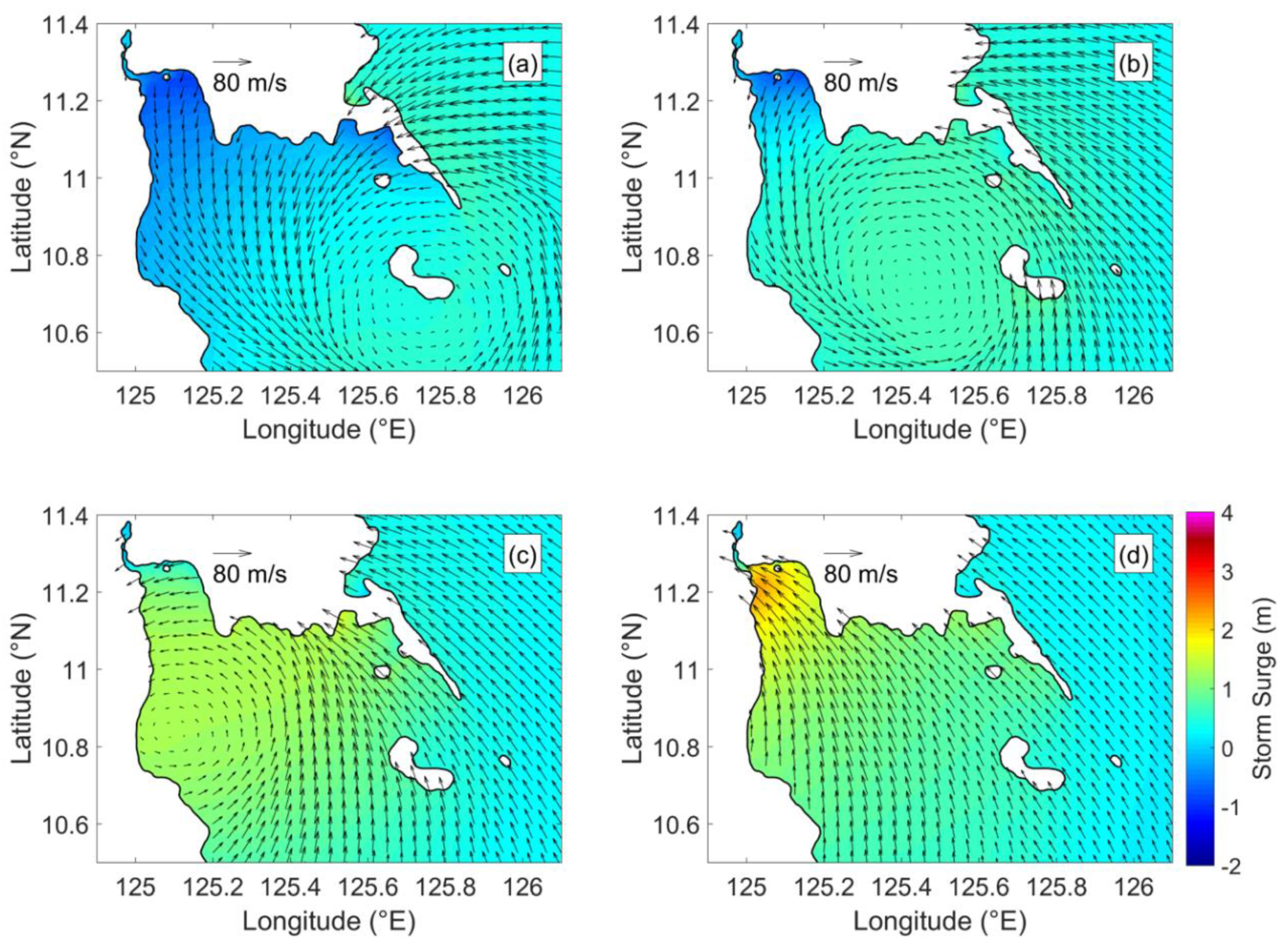
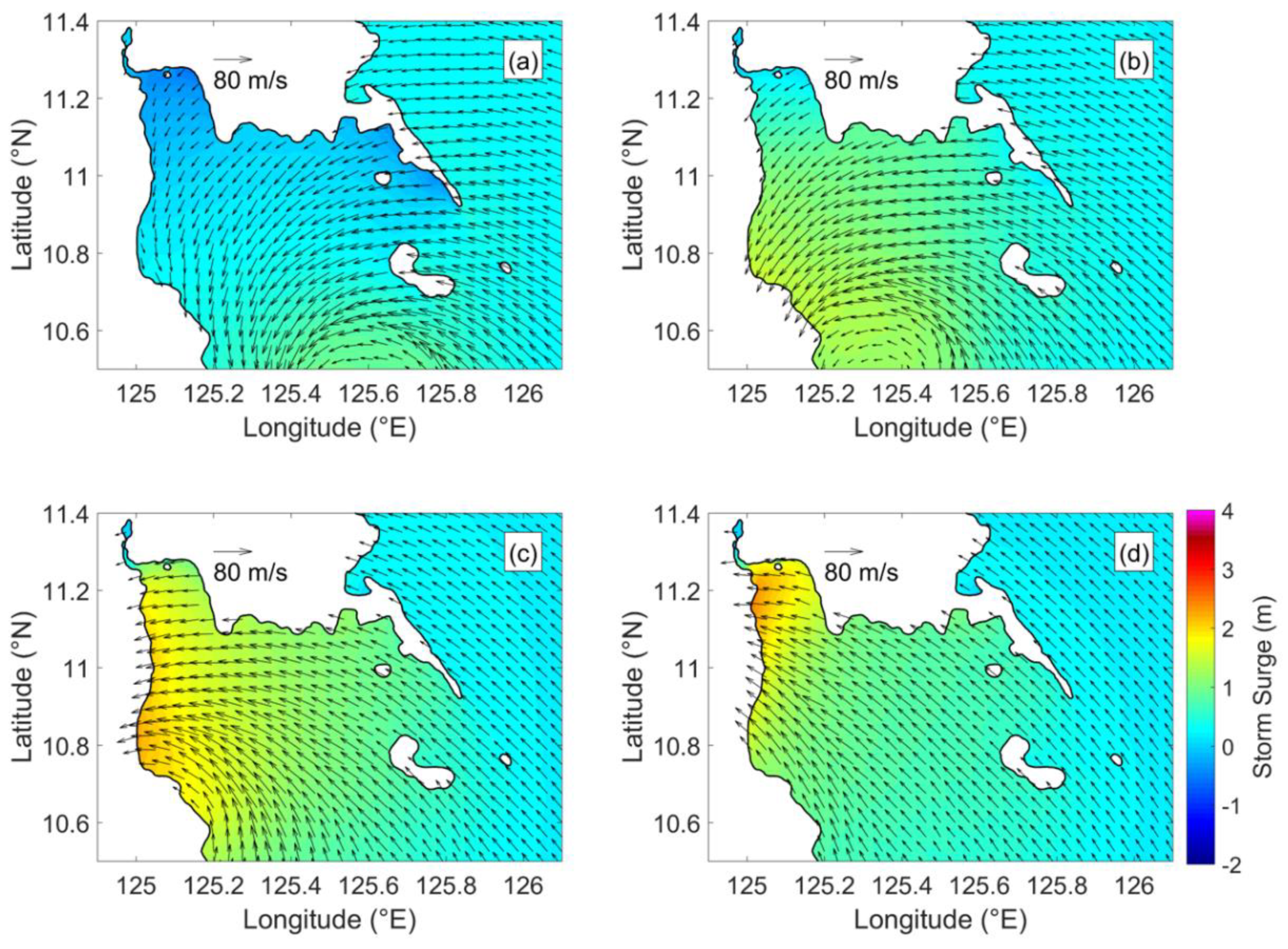
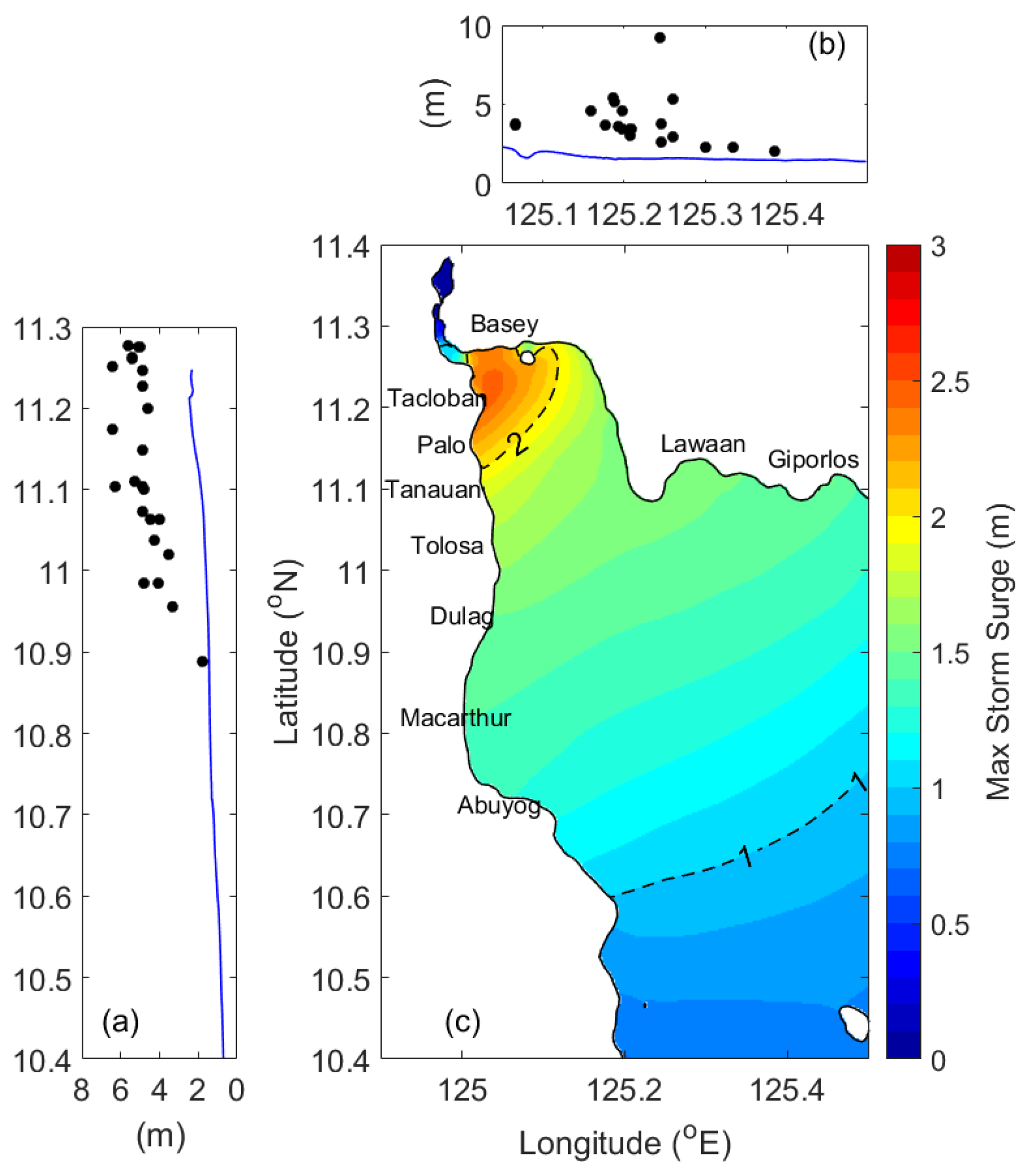
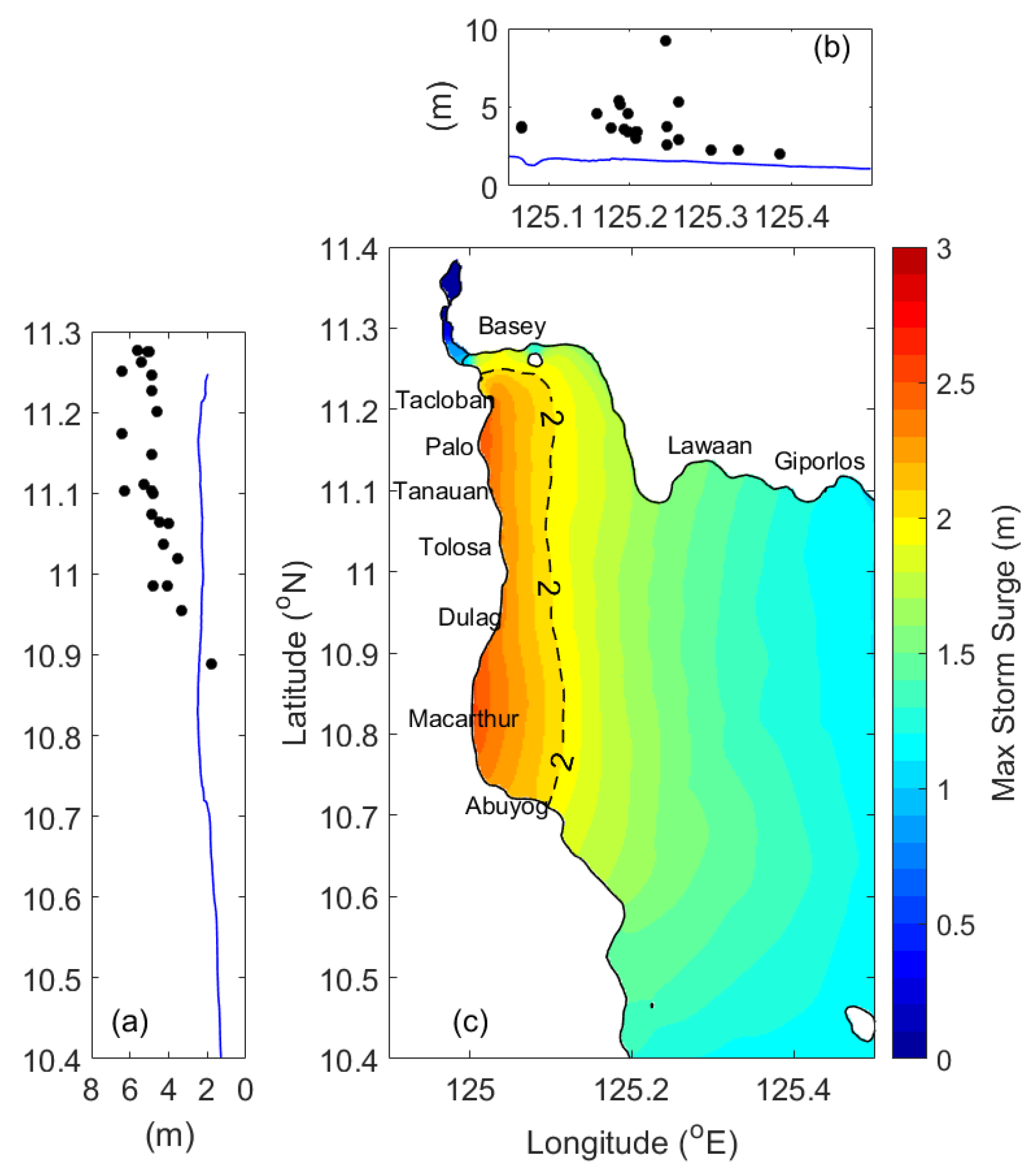
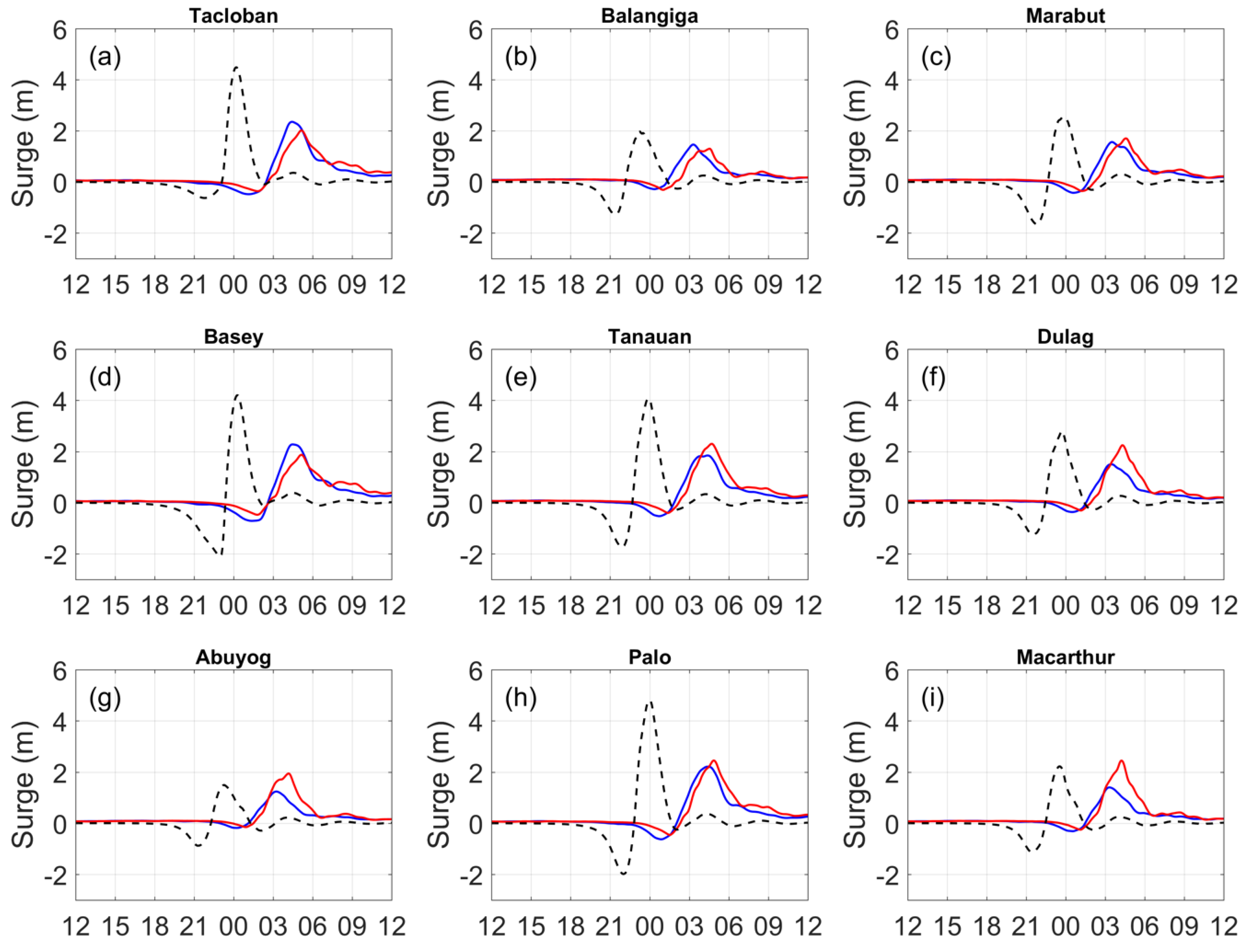

| Year | Month | Day | Hour | Longitude (° E) | Latitude (° N) | Pc (hPa) | Vmax (m/s) |
|---|---|---|---|---|---|---|---|
| 2013 | 11 | 6 | 18 | 134.4 | 8.2 | 905 | 59.16 |
| 2013 | 11 | 7 | 00 | 132.8 | 8.7 | 905 | 59.16 |
| 2013 | 11 | 7 | 06 | 131.1 | 9.3 | 905 | 59.16 |
| 2013 | 11 | 7 | 12 | 129.1 | 10.2 | 895 | 64.30 |
| 2013 | 11 | 7 | 18 | 126.9 | 10.6 | 895 | 64.30 |
| 2013 | 11 | 8 | 00 | 124.8 | 11.0 | 910 | 56.58 |
| 2013 | 11 | 8 | 06 | 122.5 | 11.4 | 940 | 46.30 |
| 2013 | 11 | 8 | 12 | 120.5 | 11.9 | 940 | 46.30 |
| 2013 | 11 | 8 | 18 | 118.0 | 12.2 | 940 | 46.30 |
| 2013 | 11 | 9 | 00 | 116.6 | 12.3 | 940 | 46.30 |
| Station Name | Longitude (° E) | Latitude (° N) |
|---|---|---|
| Balangiga | 125.3775 | 11.0934 |
| Marabut | 125.1968 | 11.1108 |
| Tacloban | 125.0199 | 11.2440 |
| Tanauan | 125.0356 | 11.1014 |
| Basey | 125.0518 | 11.2657 |
| Dulag | 125.0500 | 10.9458 |
| Abuyog | 125.1089 | 10.7137 |
| Palo | 125.0168 | 11.1560 |
| Macarthur | 125.0132 | 10.8221 |
| Date | WRF-ARW 3 km | WRF-ARW 1 km | |||||||
|---|---|---|---|---|---|---|---|---|---|
| Year | Month | Day | Hour | Longitude (° E) | Latitude (° N) | Distance (km) | Longitude (° E) | Latitude (° N) | Distance (km) |
| 2013 | 11 | 7 | 00 | 133.22 | 9.02 | 58.38 | 133.40 | 8.73 | 66.48 |
| 2013 | 11 | 7 | 06 | 131.45 | 9.32 | 38.55 | 131.60 | 9.13 | 57.74 |
| 2013 | 11 | 7 | 12 | 129.63 | 9.72 | 78.60 | 130.04 | 9.46 | 132.22 |
| 2013 | 11 | 8 | 00 | 126.06 | 10.68 | 141.60 | 126.23 | 10.40 | 169.78 |
| 2013 | 11 | 8 | 06 | 124.15 | 11.22 | 180.81 | 124.36 | 10.85 | 211.54 |
| 2013 | 11 | 8 | 12 | 121.97 | 11.99 | 160.03 | 122.27 | 11.58 | 195.66 |
| Station Name | (m) | Faster Storm Forward Motion (10% Increased) | Slower Storm Forward Motion (10% Decreased) | ||
|---|---|---|---|---|---|
(m) | (m) | ||||
| Tacloban | 4.487 | 4.701 | 4.77% | 4.259 | −5.08% |
| Balangiga | 1.985 | 1.870 | −5.79% | 2.030 | 2.27% |
| Marabut | 2.55 | 2.644 | 3.69% | 2.387 | −6.39% |
| Basey | 4.202 | 4.498 | 7.04% | 3.914 | −6.85% |
| Tanauan | 4.069 | 4.264 | 4.79% | 3.840 | −5.63% |
| Dulag | 2.798 | 2.865 | 2.39% | 2.652 | −5.22% |
| Abuyog | 1.495 | 1.407 | −5.89% | 1.534 | 2.61% |
| Palo | 4.804 | 5.039 | 4.89% | 4.547 | −5.35% |
| Macarthur | 2.225 | 2.164 | −2.74% | 2.208 | −0.76% |
Publisher’s Note: MDPI stays neutral with regard to jurisdictional claims in published maps and institutional affiliations. |
© 2020 by the authors. Licensee MDPI, Basel, Switzerland. This article is an open access article distributed under the terms and conditions of the Creative Commons Attribution (CC BY) license (http://creativecommons.org/licenses/by/4.0/).
Share and Cite
Tsai, Y.-L.; Wu, T.-R.; Lin, C.-Y.; Lin, S.C.; Yen, E.; Lin, C.-W. Discrepancies on Storm Surge Predictions by Parametric Wind Model and Numerical Weather Prediction Model in a Semi-Enclosed Bay: Case Study of Typhoon Haiyan. Water 2020, 12, 3326. https://doi.org/10.3390/w12123326
Tsai Y-L, Wu T-R, Lin C-Y, Lin SC, Yen E, Lin C-W. Discrepancies on Storm Surge Predictions by Parametric Wind Model and Numerical Weather Prediction Model in a Semi-Enclosed Bay: Case Study of Typhoon Haiyan. Water. 2020; 12(12):3326. https://doi.org/10.3390/w12123326
Chicago/Turabian StyleTsai, Yu-Lin, Tso-Ren Wu, Chuan-Yao Lin, Simon C. Lin, Eric Yen, and Chun-Wei Lin. 2020. "Discrepancies on Storm Surge Predictions by Parametric Wind Model and Numerical Weather Prediction Model in a Semi-Enclosed Bay: Case Study of Typhoon Haiyan" Water 12, no. 12: 3326. https://doi.org/10.3390/w12123326
APA StyleTsai, Y.-L., Wu, T.-R., Lin, C.-Y., Lin, S. C., Yen, E., & Lin, C.-W. (2020). Discrepancies on Storm Surge Predictions by Parametric Wind Model and Numerical Weather Prediction Model in a Semi-Enclosed Bay: Case Study of Typhoon Haiyan. Water, 12(12), 3326. https://doi.org/10.3390/w12123326






